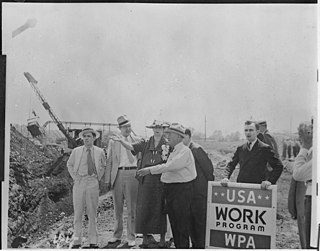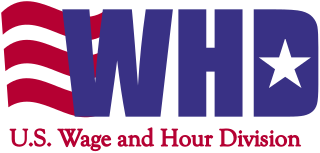Related Research Articles
Employment is a relationship between two parties regulating the provision of paid labour services. Usually based on a contract, one party, the employer, which might be a corporation, a not-for-profit organization, a co-operative, or any other entity, pays the other, the employee, in return for carrying out assigned work. Employees work in return for wages, which can be paid on the basis of an hourly rate, by piecework or an annual salary, depending on the type of work an employee does, the prevailing conditions of the sector and the bargaining power between the parties. Employees in some sectors may receive gratuities, bonus payments or stock options. In some types of employment, employees may receive benefits in addition to payment. Benefits may include health insurance, housing, and disability insurance. Employment is typically governed by employment laws, organisation or legal contracts.

Temporary work or temporary employment refers to an employment situation where the working arrangement is limited to a certain period of time based on the needs of the employing organization. Temporary employees are sometimes called "contractual", "seasonal", "interim", "casual staff", "outsourcing", "freelance"; or the words may be shortened to "temps". In some instances, temporary, highly skilled professionals refer to themselves as consultants. Increasingly, executive-level positions are also filled with interim executives or fractional executives.
Freelance, freelancer, or freelance worker, are terms commonly used for a person who is self-employed and not necessarily committed to a particular employer long-term. Freelance workers are sometimes represented by a company or a temporary agency that resells freelance labor to clients; others work independently or use professional associations or websites to get work.
An employment contract or contract of employment is a kind of contract used in labour law to attribute rights and responsibilities between parties to a bargain. The contract is between an "employee" and an "employer". It has arisen out of the old master-servant law, used before the 20th century. Employment contracts relies on the concept of authority, in which the employee agrees to accept the authority of the employer and in exchange, the employer agrees to pay the employee a stated wage.
Workfare is a governmental plan under which welfare recipients are required to accept public-service jobs or to participate in job training. Many countries around the world have adopted workfare to reduce poverty among able-bodied adults; however, their approaches to execution vary. The United States and United Kingdom are two countries utilizing workfare, albeit with different backgrounds.

Workforce Australia is an Australian Government-funded network of organisations that are contracted by the Australian Government, through the Department of Employment and Workplace Relations (DEWR), to deliver employment services to unemployed job seekers on Government income support payments and employers.

An employment agency is an organization which matches employers to employees. In developed countries, there are multiple private businesses which act as employment agencies and a publicly funded employment agency.
The term sheltered workshop refers to an organization or environment that employs people with disabilities separately from others, usually with exemptions from labor standards, including but not limited to the absence of minimum wage requirements.

The Commonwealth Employment Service (CES) was an Australian Government employment agency that was established in 1946 with the introduction of the Re-establishment and Employment Act 1945 under the Curtin ALP government. It was designed to identify labour shortages, and solve them through supplying labour. It also conducted a "work test" of welfare recipients, to prove their willingness (and ability) to work.
The United States Social Security Administration's Ticket to Work and Self-Sufficiency Program is the centerpiece of the Ticket to Work and Work Incentives Improvement Act of 1999.
Supported employment refers to service provisions wherein people with disabilities, including intellectual disabilities, mental health, and traumatic brain injury, among others, are assisted with obtaining and maintaining employment. Supported employment is considered to be one form of employment in which wages are expected, together with benefits from an employer in a competitive workplace, though some versions refer to disability agency paid employment. Companies such as Skilcraft in the United States are an example of "supported employment" which is defined in law for state and federal reimbursements.
The Senior Community Service Employment Program (SCSEP) is a program of the United States Department of Labor, its Employment and Training Administration, to help more senior citizens get back into or remain active in the labor workforce. It is a community service and work-based training program. It does this through job skill training and employment assistance with an emphasis on getting a ready job with a suitable and cooperating company or organisation. In such a setting, the worker is paid the United States minimum wage, or the highest of Federal, State or local minimum wage, or the prevailing wage, for an average of 20 hours per week, and experiences on-the-job learning and newly acquired skills use. The intention is that through these community jobs, the older worker will gain a permanent job, not subsidized by federal government funds.

A job guarantee is an economic policy proposal that aims to create full employment and price stability by having the state promise to hire unemployed workers as an employer of last resort (ELR). It aims to provide a sustainable solution to inflation and unemployment.
Fedcap Rehabilitation Services, Inc., or Fedcap, is a Manhattan-based non-profit organization that provides vocational training and employment resources to those who face problems with disabilities and employment-related problems.

The Wage and Hour Division (WHD) of the United States Department of Labor is the federal office responsible for enforcing federal labor laws. The Division was formed with the enactment of the Fair Labor Standards Act of 1938. The Wage and Hour mission is to promote and achieve compliance with labor standards to protect and enhance the welfare of the Nation's workforce. WHD protects over 144 million workers in more than 9.8 million establishments throughout the United States and its territories. The Wage and Hour Division enforces over 13 laws, most notably the Fair Labor Standards Act and the Family Medical Leave Act. In FY18, WHD recovered $304,000,000 in back wages for over 240,000 workers and followed up FY19, with a record-breaking $322,000,000 for over 300,000 workers.
Workforce development, an American approach to economic development, attempts to enhance a region's economic stability and prosperity by focusing on people rather than businesses. It essentially develops a human-resources strategy. Work-force development has evolved from a problem-focused approach, addressing issues such as low-skilled workers or the need for more employees in a particular industry, to a holistic approach considering participants' many barriers and the overall needs of the region.

The Wisconsin Department of Workforce Development (DWD) is an agency of the Wisconsin state government responsible for providing services to Wisconsin workers, employers, and job-seekers to meet Wisconsin's workforce needs. To effect its mission, the Department administers unemployment benefits and workers' compensation programs for the state of Wisconsin; ensures compliance with state laws on wages and discrimination; provides job resources, training, and employment assistance for job-seekers; and engages with employers to help them find and maintain adequate staffing for their businesses.

Gig workers are independent contractors, online platform workers, contract firm workers, on-call workers, and temporary workers. Gig workers enter into formal agreements with on-demand companies to provide services to the company's clients.
Paid prison labour is the participation of convicted prisoners in either voluntary or mandatory paid work programs.
Labour hire is a form of employment in which an employer directs their de jure employees to perform work at an external workplace, belonging to a client of the legal employer.
References
- DE Balducchi, RW Eberts, CJ O'Leary (eds), Labour Exchange Policy in the United States (W.E. Upjohn Institute for Employment Research 2004)
- P Craig, M Freedland, C Jacqueson and N Kountouris, Public Employment Services and European Law (2007)
- International Labour Office, The role of private employment agencies in the functioning of labour markets (Report VI 1994) International Labour Conference 81st Session
- R Kellogg, The United States Employment Service (University of Chicago Press 1933)
- T Martinez, The Human Marketplace: An Examination of Private Employment Agencies (Transaction 1976)
- JB Seymour, The British Employment Exchange (PS King & Son 1928)